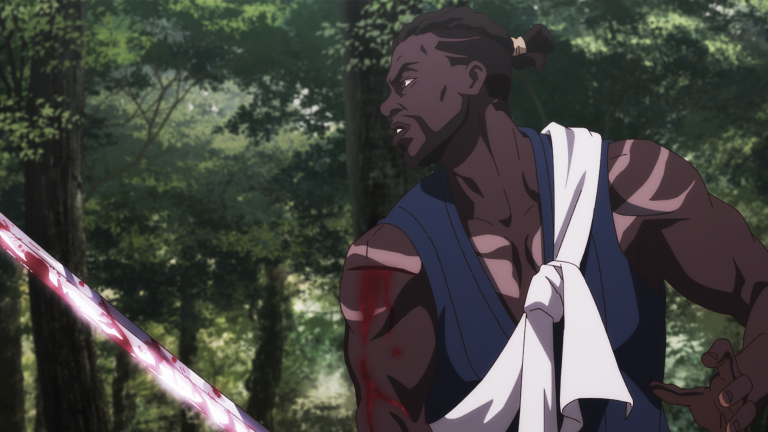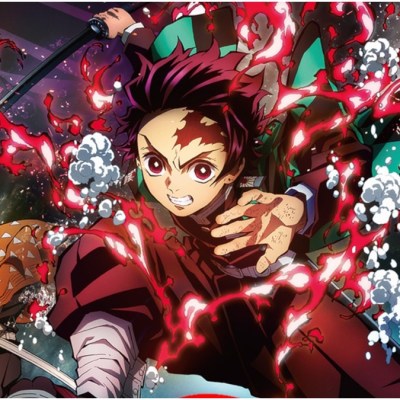Yasuke Review: Netflix Anime Reclaims The Story of a Black Samurai
Jaw-dropping in design, Yasuke has a lot of trouble fleshing out its main subject but it’s still an entertaining storm.

This Yasuke review contains no spoilers.
What’s supposedly last known about Yasuke, the documented 16th-century Black samurai of Japan, is that he was brought back into the hands of his former Jesuit owners after his samurai employment was cut short. From there, the African-originated warrior, who remarkably rose to impressive status under the warlord Oda Nobunaga despite his being a foreigner, appears to vanish from history.
Both historical and legendary, Yasuke had nary a chance to grace onscreen media, although he allegedly inspired the protagonist of the densely shaded neo-noir Afro Samurai manga-based anime. He was the star of an infamous Japanese children’s book that infamously ended in seppuku and also appeared in the 2017 video game Nioh. Had tragedy not claimed Chadwick Boseman, the actor would have starred as the samurai in a now-scrapped movie project.
Now creator and director LeSean Thomas (Cannon Busters, The Boondocks, Black Dynamite) and writer Nick Jones Jr. are imagining this historical legend in the MAPPA-produced anime sheen of magic, werewolves, mechas, and nods to speculative history. In the words of Thomas himself on the Netflix blog, it is of “serendipitous nature about this project, how an African-American man goes to Japan to live and work amongst the very best in Japanese anime to create an anime about an African who goes to Japan to live amongst the Japanese elite and become a warrior.” Indeed, the significance of Thomas’s project centering a historical Black man in Japan is understood with further reading on how Blackness and anti-Blackness manifested in anime.
The anime opens in the midst of a waning victory in a battlefield of swordsmen soldiers, archers, mechas, and magic. As the war storm rages, an armored Yasuke (LaKeith Stanfield, also executive producer) witnesses his lord commit seppuku. Two decades later, the former samurai exists as a recluse with barely a purpose. He has sunk into his role as a sullen boatman in a small village, but he is amiably approachable enough that village kids can expect him to toss them his fish catch or pass them swordplay tips. But soon, circumstances drag him back into honor-bound duty when a mother (Gwendoline Yeo) implores him to ferry her frail daughter Saki (Maya Tanida), ridden with mysterious magic she cannot control, to a special doctor. Yasuke’s honor and abilities are put to the test.
In the meantime, Yasuke rethinks his past bonds and allegiances during his miraculous tenure as a samurai under daimyō Oda Nobunaga. In spite of the samurai opportunity handed to him, a foreigner, on a golden platter, Yasuke is perpetually reminded he must prove his prestige as one of his elite guards. His pariah status among the Japanese elites is also what allows him to forge a friendship with the cryptic soul Natsumaru (Ming-Na Wen), the only Onna Bugeisha female samurai under their shared lordship.
Despite a compelling setup, the story has trouble fleshing out the psychological baggage of its fictionalized eponymous subject. This is most evident when Yasuke confronts a key double-crossing and its emotional consequences have the impact of a blunt sword. Yasuke is so quick and interested in tightening its tale that it does not permit the breathing space to unravel its lead samurai’s past, especially the promised emotional nuances of his allegiance to a warlord. It’s also difficult to pinpoint whether the flashbacks overstay its their welcome or don’t achieve the emotional economy.
It is only midway through the story when the lone warrior and his child companion have time to connect that the firecrackers go off. The guarded Stanfield and the buoyant Tanida play off each other with accumulating respect, wholesome affection, and matching energy—“WE protect each other,” the little girl insists. It’s a dynamic that could have charged out one or two more episodes, and it would perk up viewers who dig the “solitary father figure bonding with chaotic powerful child” trope in The Mandalorian (which was inspired by A Lone Wolf and Cub). It is a letdown that Stanfield doesn’t spark as much chemistry with an otherwise competent Wen, stemming from the underbaked nature of their characters’ relationships.
The young girl’s arc to control her power and self-esteem is straightforward and therefore the easiest to follow, but because the show underwrites the complexities of Yasuke’s baggage, its main subject’s quest to overcome an identity crisis and assert his existence does not fare as well. But it’s when Yasuke shows his combative and moral prowess on the battlefield that he shines most as a character. Stanfield’s Yasuke is convincing as a soul who embodies personal convictions: his honor, desire to prevent bloodshed, and his reverence such as when he closes the eyelids of his decapitated opponent and prays.
If you’re critical of the story, there’s still plenty to enjoy about the surface-level dynamics, journeys, and striking symbolic imagery. When Yasuke occupies itself in its twistedly bizarre feudal setting, it indulges in some real fun weirdness. Enter a troupe of ruthless bounty hunters: a hulking Russian werewolf woman (Julie Marcus), a shaman (William Christopher Stephens) hailing from the Benin Kingdom who can summon phantom fighters, a spandex-clad assassin (Dia Frampton) waving scepters, and a scene-stealing sentient mecha (Darren Criss) with a Baymax inflection who ruminates on statistical success and teamwork. These bounty hunters are sure to be fan favorites and the story soon engineers them back into the narrative when they exit.
From forested sceneries, earthly purple-bathed soldier-littered battlefields, and luminous astral planes, Yasuke is polished visually with hardy character designs by Takeshi Koike, world art and art setting designs by Minoru Nishida, vivid art direction by Junichi Higashi, and color setting designer Azusa Sasaki. From the MAPPA studio that brought In This Corner of the World and Attack on Titan, its sweeping scale is no surprise.
The Grammy-nominated Flying Lotus also contributes to the mellow electronic beats that prevail whenever Yasuke proves himself in combat. Other than contributing to the story, Flying Lotus provides the soulful opening theme “Black Gold,” performed by Thundercat, and a lulling closing theme “between memories” with lyrics and performance by Niki Randa. Both songs befit the warmth of its star samurai.
Yasuke resolves itself in a tight package. But stay for the end credits and it’s evident there’s a continuation teased without being a cliffhanger. I’m not sure whether its story proved Yasuke can sustain for additional seasons. Still, there is something about the sincere romanticism of imagining a vanished historical figure and giving him more dignified possibilities than (speculative) history could have ever given him.
All six episodes of Yasuke will be available to stream April 29 on Netflix.


